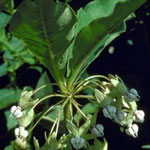MONARCH
BUTTERFLY
The Aztecs
believed the souls of the departed remained on earth in the form
of butterflies. Even images carved in the ancient Aztec
monuments show this belief - linking the spirits of the
dead and the Monarch butterfly.
Every autumn
Monarch Butterflies, which have summered up north in the United
States and Canada, return to Mexico for the winter protection of
the oyamel fir trees. The local inhabitants welcome
back the returning butterflies, which they believe bear the
spirits of their departed. The spirits to be honored during Los
Dias de los Muertos.
Borne aloft on
brightly colored wings, the monarch butterfly completes a
marvelous feat of endurance each year, migrating thousands of
miles to spend the winter in California and Mexico.
 HABITS HABITS
The monarch
butterfly is found throughout North and South America wherever
the milkweed plant grows. The monarch larvae feed on various
types of milkweed, which thrives in open spaces, as well as
beside roads, along woodland edges, on empty lots, and in
overgrazed pastures. Anywhere milkweed grows, monarchs thrive.
BREEDING
In early spring
monarch butterflies come out of hibernation and begin their
migration north.
 Many
stop to mate and lay their eggs on milkweed plants. The eggs
hatch into caterpillars within a few days. After the
caterpillars pupate and become butterflies a month later, they
also join the northward flight. Many
stop to mate and lay their eggs on milkweed plants. The eggs
hatch into caterpillars within a few days. After the
caterpillars pupate and become butterflies a month later, they
also join the northward flight.
During the flight,
the newly-adult butterflies may also stop to breed. Up to five
generations of monarch butterflies may migrate in one season.
All monarch butterflies congregate at specific winter roost
sites in California and Mexico.
MIGRATION
Despite its
paper-thin wings. the monarch butterfly is a powerful flyer
with uncanny endurance. It is best known for its annual
migration through-sometimes as far as 3000 miles-North America
to California and Mexico. Monarch Butterflies that breed in
the temperate parts of North America migrate so that their
eggs and caterpillars won't be killed by prolonged winter
frost. For this reason, the autumn monarch broods are more
likely to migrate than those that are hatched during the warm
spring weather.
The 5 million
monarch butterflies from western North America head for a small
number of sites scattered along the coast of California. The 100
million butterflies from the eastern part of the country head
south to Michoacan in Central Mexico.
During the last
200 years, the monarch butterfly has also succeeded in
colonizing places as far away as Hawaii, Fiji, Australis, and
New Zealand. These tropical monarch butterflies tend to be less
mobile than their relatives in the temperate zones, seldom
needing to travel far from their warm habitat.
HIBERNATION
The crowded
winter roosts of the monarch butterfly are one of the natural
wonders of the world. In Mexico, the roosting sites of the
eastern monarch butterfly consist of a small area of pine
forest. As many as 15 million orange and black butterflies cover
the trees at one time. The temperature of the roost should be
just above freezing. If it is too cold, the butterflies will
die; if it is too warm, they will wake up and expend valuable
energy.
KEY FACTS
-
Length:
in. (body).
-
Mouthparts:
Sucking in adult.
-
Wings:
2 pairs of flying wings.
-
Wingspan:
3 in.
-
Eggs:
Number variable.
-
Hatching
time:3-4
days.
-
Development
time of caterpillars:
3-4 weeks.
-
Diet:
Larvae feed on milkweed; adults feed on flower nectar.
-
Lifespan:3-4
weeks in summer generations; 7-8 months in over-wintered
generations.
-
The similar
African monarch, Danaus chrysippus.
DID
YOU KNOW?
- The
longest recorded flight of a monarch butterfly is
over 3,000 miles. While migrating, it can cover 80
miles a day.
- The
monarch butterfly is believed to have reached some
of the islands it has colonized by hanging on to the
riggings.
- The
monarch makes its migratory flight at speeds of up
to 11 miles per hour. It travels 16 or 17 feet above
the ground.
|
|